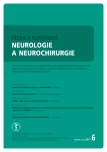When to Operate on Temporal Bone Fractures?
Authors:
Viktor Chrobok 1
; Michal Černý 1
; Jana Šatanková 1
; Jan Mejzlík 1
; Jana Dědková 2; M. Kanta 3; L. Školoudík 1
Authors‘ workplace:
LF UK a FN Hradec Králové
Klinika otorinolaryngologie
LF UK a FN Hradec Králové
a chirurgie hlavy a krku
1; LF UK a FN Hradec Králové
Radiodiagnostická klinika
2; LF UK a FN Hradec Králové
Neurochirurgická klinika
3
Published in:
Cesk Slov Neurol N 2017; 80(6): 685-689
Category:
Original Paper
doi:
https://doi.org/10.14735/amcsnn2017685
Overview
Aim:
To evaluate the possibilities and indications of surgical treatment of temporal bone fracture and verify concordance with international experience.
Methods:
Eleven patients treated surgically for temporal bone fracture at the Department of Otorhinolaryngology and Head and Neck Surgery, University Hospital Hradec Králové in 2011–2016 were evaluated retrospectively. Fractures in the petrous and non-petrous part with and without otic capsule involvement were distinguished according to the high-resolution computed tomography scans and the performed surgical treatment was evaluated.
Results:
Four patients had a fracture in the non-petrous part, 7 patients had a fracture in the petrous part, otic capsule was involved in 6 out of these 7 patients. Decompression of facial nerve was carried out in 6 patients. Subtotal petrosectomy was primarily used in 4 patients and secondarily after facial nerve decompression in 1 patient. In another patient, facial nerve decompression and subtotal petrosectomy was performed simultaneously. Posttraumatic cholesteatoma was found in 2 out of 6 subtotal petrosectomy surgeries, from those one patient was after preceding decompression of facial nerve. Previous purulent meningitis was present in 4 patients.
Discussion:
Decompression of facial nerve in selected patients with facial nerve palsy is an indication for early surgical treatment of temporal bone fractures. Elective subtotal petrosectomy is considered in fractures in the petrous part involving the otic capsule with the aim of preventing posttraumatic otogenic meningitis. It is mainly indicated in patients with posttraumatic otogenic meningitis or patients with posttraumatic decompression of the facial nerve with concurrent deafness.
Key words:
skull base fractures – temporal bone – meningitis – facial nerve – petrosectomy
The authors declare they have no potential conflicts of interest concerning drugs, products, or services used in the study.
The Editorial Board declares that the manuscript met the ICMJE “uniform requirements” for biomedical papers.
Chinese summary - 摘要
何时手术治疗颞骨骨折?目标:
评估手术治疗颞骨骨折的可能性和适应证,并验证其与国际经验的一致性。
方法:
回顾性分析了2011 - 2016年在赫拉德茨 - 克拉洛韦大学医院耳鼻咽喉头颈外科接受手术治疗颞骨骨折的11名患者。根据高分辨率计算机断层扫描对涉及或不涉及耳囊的岩部和非岩部位的骨折进行鉴别,并对所执行的手术治疗进行评估。
结果:
4例患者在非岩骨部位发生骨折,7例患者是岩部骨折,并且7例患者中有6例患者涉及耳囊。 6例患者进行了面神经减压。 次全切除术主要用于4例患者,其次用于1例面神经减压术后患者。 其它患者同时行面神经减压和次全切除术。6例次全切除手术中发现有2例患有外伤性胆脂瘤,其中一名患者在面神经减压之后。有4例患者先前出现了脓性脑膜炎。
讨论:
面神经麻痹患者的面神经减压术是颞骨骨折早期手术治疗的一种适应症。在涉及耳囊的岩骨部位骨折中考虑选择次全切除术,目的是防止创伤后的耳源性脑膜炎。主要表现在创伤后耳源性脑膜炎患者或创伤后面神经减压术伴有并发性耳聋的患者。
关键词:
颅底骨折 - 颞骨 - 脑膜炎 - 面神经 - 岩部切除术
Sources
1. Kang HM, Kim MG, Boo SH, et al. Comparison of the clinical relevance of traditional and new classification systems of temporal bone fractures. Eur Arch Otorhinolaryngol 2012;269(8):1893– 9. doi: 10.1007/ s00405-011-1849-7.
2. Šatanková J, Dědková J, Chrobok V. Klinický pohled otorinolaryngologa a rentgenologa na klasifikaci zlomenin spánkové kosti. Cesk Slov Neurol N 2017;80/ 113(4):457– 63. doi: 10.14735/ amcsnn2017457.
3. Fisch U. Prognostic value of electrical tests in acute facial paralysis. Am J Otol 1984;5(6):494– 8.
4. Chang CY, Cass SP. Management of facial nerve injury due temporal bone trauma. 1999;20(1):96– 114.
5. Yetiser S. Total facial nerve decompression for severe traumatic facial nerve paralysis: a review of 10 cases. Int J Otolaryngol 2012;607359, doi: 10.1155/ 2012/ 607359.
6. Hato N, Nota J, Hakuba N, et al. Facial nerve decompression surgery in patients with temporal bone trauma: analysis of 66 cases. J Trauma 2011;71(6):1789– 93. doi: 10.1097/ TA.0b013e318236b21f.
7. Patel A, Groppo E. Management of temporal bone trauma. Craniomaxillofac Trauma Reconstr 2010;3(2): 105– 13. doi: 10.1055/ s-0030-1254383.
8. Darrouzet V, Duclos JY, Liguoro D, et al. Management of facial paralysis resulting from temporal bone fractures. Otolaryngol Head Neck Surg 2001;125(1):77– 84. doi: 10.1067/ mhn.2001.116182.
9. Caylan R, Bektas D, Dikmen T, et al. Mesenchymal stem cells in iatrogenic facial nerve paralysis: a possible role in the future. Eur Arch Otorhinolaryngol 2006;263(10): 963– 7. doi: 10.1007/ s00405-006-0093-z.
10. Skoloudik L, Chrobok V, Kalfert D, et al. Multipotent mesenchymal stromal cells in otorhinolaryngology. Med Hypotheses 2014;82(6):769– 73. doi: 10.1016/ j.mehy.2014.03.022.
11. Aslan H, Songu M, Eren E, et al. Results of decompression with middle cranial fossa approach or traumatic intratemporal fascial nerve injury. J Craniofac Surg 2014;25(4):1305– 8. doi: 10.1097/ SCS.0000000000000772.
12. Liu Y, Han J, Zhou X, et al. Surgical management of facial paralysis resulting from temporal bone fractures. Acta Otolaryngol 2014;134(6):656– 60. doi: 10.3109/ 00 016489.2014.892214.
13. Cvorovic L, Jovanovic MB, Markovic M, et al. Management of complication from temporal bone fractures. Eur Arch Otorhinolaryngol 2012;269(2):399– 403. doi: 10.1007/ s00405-011-1641-8.
14. Nash JJ, Friedland DR, Boorsma KJ, et al. Management and outcomes of facial paralysis from intratemporal blunt trauma: a systematic review. Laryngoscope 2010;120(7):1397– 404. doi: 10.1002/ lary.20943.
Labels
Paediatric neurology Neurosurgery NeurologyArticle was published in
Czech and Slovak Neurology and Neurosurgery

2017 Issue 6
- Metamizole vs. Tramadol in Postoperative Analgesia
- Memantine in Dementia Therapy – Current Findings and Possible Future Applications
- Memantine Eases Daily Life for Patients and Caregivers
- Metamizole at a Glance and in Practice – Effective Non-Opioid Analgesic for All Ages
- Advances in the Treatment of Myasthenia Gravis on the Horizon
Most read in this issue
- Brief Test of Verbal Memory Using the Sentence in Alzheimer Disease
- State-of-the-Art MRI Techniques for Multiple Sclerosis
- H-reflex and Its Role in EMG Laboratory and Clinical Practice
- When to Operate on Temporal Bone Fractures?
